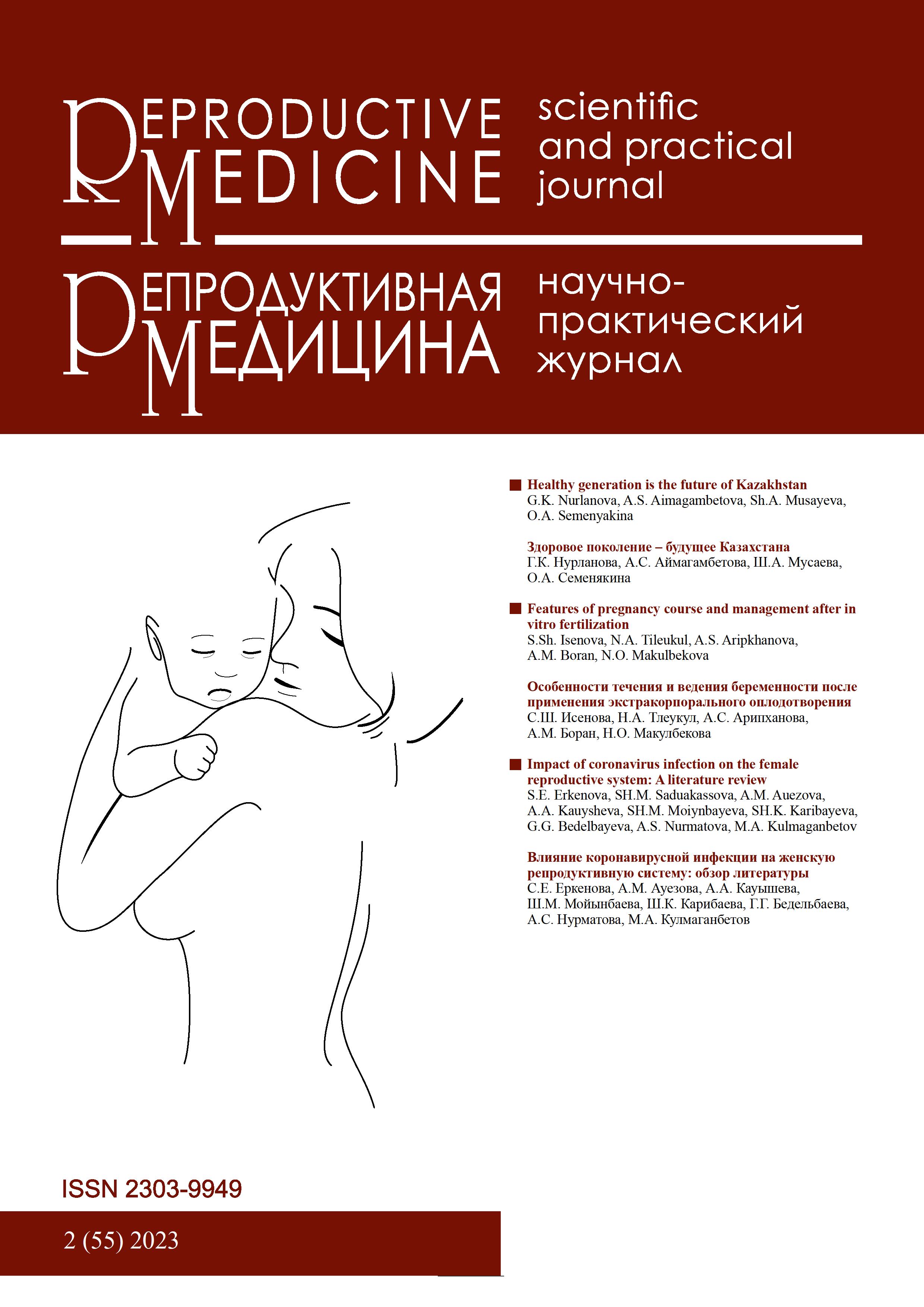Obesity and fertility: A literature review
DOI:
https://doi.org/10.37800/RM.2.2023.39-45Keywords:
obesity, infertility, anovulation, fertilityAbstract
Relevance: Female obesity is a complex multifactorial disease. Many mechanisms involved in overweight and obesity affect the development of reproductive disorders. Important mechanisms include insulin resistance, hyperinsulinemia, hyperandrogenism, lipotoxicity, and inflammation. However, the exact mechanism concerning their relationship is still unclear. Excess adipose tissue aromatizes androgens into estrogen, which leads to negative feedback on the hypothalamic-pituitary axis and, finally, to a decrease in gonadotropin production and a lower level of gonadotropins leads to inhibition of ovarian activity and menstrual cycle disorders and infertility. Also, impaired endometrial susceptibility in obese women is the cause of unsuccessful embryo implantation and infertility. As you know, female obesity has become a global problem, which in most cases, is accompanied by endocrine and metabolic disorders. Obese women are more likely to face reproductive problems, including infertility, defects in embryonic development, and abnormalities in offspring. In this regard, the relevance of this topic is undeniable.
The study aimed to investigate the effect of obesity on the fertility of women of reproductive age.
Materials and methods: We used articles in English found in the search engines like PubMed, Scopus, Google Scholar, and e-Library by keywords and medical thematic headings among the materials published from 2012 to 2022. The review included 26 articles on the pathogenesis, etiology, influence, and treatment of obesity in the reproductive age. The studies were conducted in compliance with applicable ethical principles.
Results: The effect of obesity on fertility has an assumed etiological role, but knowledge of physiopathology is still insufficient. Treatment is aimed at the minimal intervention necessary to restore fertility. Placental dysfunction due to maternal obesity may be associated with the development of fetal growth restriction, and the fetus does not reach its full growth potential. Weight loss can help improve ovulation, pregnancy, and live birth; therefore, women with a high body mass index should be advised to lose weight before conception.
Conclusion: Obesity in women is associated with the risk of infertility and negative consequences for the fetus. Fortunately, these adverse effects can be avoided with moderate weight loss. Deeper research is required to better understand the relationship between obesity and the female reproductive system to improve women's health.
References
Всеобщая декларация о биоэтике и правах человека: утв. резолюцией Генеральной конференции ЮНЕСКО 19 октября 2005 года [Vseobshhaya deklaraciya o bioe'tike i pravax cheloveka: utv. rezolyuciej General'noj konferencii YuNESKO 19 oktyabrya 2005 goda (in Russ.)]. https://www.un.org/ru/documents/decl_conv/declarations/bioethics_and_hr.shtml
Chooi Y.C., Ding C., Magkos F. The epidemiology of obesity // Metabolism. – 2019. – Vol. 92. – P. 6-10. https://doi.org/10.1016/j.metabol.2018.09.005
Darcy E Broughton, Kelle H Moley. Fertil Steril. 2017 Apr; 107 (4): 840-847. https://doi.org/10.1016/j.fertnsert.2017.01.017
Davis A.M. Collateral damage: maternal obesity during pregnancy continues to rise // Obstet. Gynecol. Surv. – 2020. – Vol. 75(1). – P. 39-49. https://doi.org/10.1097/OGX.0000000000000734
Stang J., Huffman L.G. Position of the academy of nutrition and dietetics: Obesity, reproduction, and pregnancy outcomes // J. Acad. Nutr. Diet. – 2016. – Vol. 116(4). – P. 677-691. https://doi.org/10.1016/j.jand.2016.01.008
Wong M.G., The N.L., Glastras S. Maternal obesity and offspring risk of chronic kidney disease // Nephrol (Carlton). – 2018. – Vol. 23(4). – P. 84-87. https://doi.org/10.1111/nep.13462
Ou X.H., Zhu C.C., Sun S.C. Effects of obesity and diabetes on the epigenetic modification of mammalian gametes // J. Cell. Physiol. – 2019. – Vol. 234(6). – P. 7847-7855. https://doi.org/10.1002/jcp.27847
K. Green, J. Zolton, S. Schermerhorn, T. Lewis, M. Healy, N. Terry, A. De Cherney, M. Hill // Fertil Steril. 2017 Apr; 107 (4): 924-933.e5. https://doi.org/10.1016/j.fertnsert.2017.01.011
Broughton D.E., Moley K.H. Obesity and female infertility: potential mediators of obesity's impact // Fertil. Steril. – 2017. – Vol. 107(4). – P. 840-847. https://doi.org/10.1016/j.fertnstert.2017.01.017
Xu H., Li P.H., Barrow T.M., Colicino E., Li C., Song R., Liu H. , Tang N., Liu S., Guo L., Byun H. Obesity as an effect modifier of the association between menstrual abnormalities and hypertension in young adult women: Results from project ELEFANT // PloS One. – 2018. – Vol. 13(11). – P. e0207929. https://doi.org/10.1371/journal.pone.0207929
Klump K.L., Racine S.E., Hildebrandt B., Burt S.A., Neale M., Sisk C.L. S. Boker, and P. K. Keel. Ovarian hormone influences on dysregulated eating: A comparison of associations in women with versus without binge episodes // Clin. Psychol. Sci. – 2014. – Vol. 2(4). – P. 545–559. https://doi.org/10.1177/2167702614521794
Clinical significance of serum gonadotropin and androgen levels among Egiptian overweight/obese pubertal girls. // Journal of Complementary and Integrative Medicine, vol.19, no. 2, 2022, pp. 389-398. https://doi.org/10.1515/jcim-2020-0260
Stewart C.E., Sohrabji F. Gonadal hormones and stroke risk: PCOS as a case study // Front. Neuroendocrinol. – 2020. – Vol. 58. – Art. no. 100853. https://doi.org/10.1016/j.yfrne.2020.100853
Kohlmeier A., Sison C.A.M., Yilmaz B.D., Coon V.J.S., Dyson M.T., Bulun S.E. GATA2 and progesterone receptor interaction in endometrial stromal cells undergoing decidualization // Endocrinology. – 2020. – Vol. 161(6). – Art. no. bqaa070. https://doi.org/10.1210/endocr/gqaa070
Rhee J.S., Saben J.L., Mayer A.L., Schulte M.B., Asghar Z., Stephens C., Maggie M.-Y. Chi, Kelle H. Moley. Diet-induced obesity impairs endometrial stromal cell decidualization: a potential role for impaired autophagy // Hum. Reprod. – 2016. – Vol. 31(6). – P. 1315-1326. https://doi.org/10.1093/humrep/dew048
Yang T., Zhao J., Liu F., Li Y. Lipid metabolism and endometrial receptivity // Hum. Reprod. Update. – 2022. – Vol. 27. – Art. no. dmac026. https://doi.org/10.1093/humupd/dmac026
Cena H., Chiovato L., Nappi R.E. Obesity, polycystic ovary syndrome, and infertility: A new avenue for GLP-1 receptor agonists // J. Clin. Endocrinol Metab. – 2020. – Vol. 105(8). – P. e2695- e2709. https://doi.org/10.1210/clinem/dgaa285
De Medeiros S.F., Rodgers R.J., Norman R.J. Adipocyte and steroidogenic cell cross-talk in polycystic ovary syndrome // Hum. Reprod. Update. – 2021. – Vol. 27(4). – P. 771-796. https://doi.org/10.1093/humupd/dmab004
Escobar-Morreale H.F. Polycystic ovary syndrome: definition, aetiology, diagnosis and treatment // Nat. Rev. Endocrinol. – 2018. – Vol. 14(5). – P. 270-284. https://doi.org/10.1038/nrendo.2018.24
Cho S.H., Leonard S.A., Lyndon A., Main E.K., Abrams B., Hameed A.B., S.L. Carmichael. Pre-pregnancy obesity and the risk of peripartum cardiomyopathy // Am. J. Perinatol. – 2021. – Vol. 38(12). – P. 1289-1296. https://doi.org/10.1055/s-0040-1712451
Parrettini S., Caroli A., Torlone E. Nutrition and metabolic adaptations in physiological and complicated pregnancy: focus on obesity and gestational diabetes // Front. Endocrinol. (Lausanne). – 2020. – Vol. 11(5). – Art. no. 611929. https://doi.org/10.3389/fendo.2020.611929
Leary C., Leese H.J., Sturmey R.G. Human embryos from overweight and obese women display phenotypic and metabolic abnormalities // Hum. Reprod. – 2015. – Vol. 30(1). – P. 122-132. https://doi.org/10.1093/humrep/deu276
Gaccioli F., Lager S., Powell T.L., Jansson T. Placental transport in response to altered maternal nutrition // J. Dev. Orig. Health Dis. – 2013. – Vol. 4(2). – P. 101-115. https://doi.org/10.1017/S2040174412000529
Araujo-Silva V.C., Santos-Silva A., Lourenço A.S., Barros-Barbosa C.M., Moraes-Souza R.Q., B. Karki, V. Gonçalves Paula,Y. Sinzato, D. Damasceno, G. Volpato. Congenital anomalies programmed by maternal diabetes and obesity on offspring of rats // Front. Physiol. – 2021. – Vol. 12. – Art. no. 701767. https://doi.org/10.3389/fphys.2021.701767.
Brite J., Laughon S.K., Troendle J., Mills J. Maternal overweight and obesity and risk of congenital heart defects in offspring // J. Obes. – 2014. – Vol. 38(6). – P. 878-882. https://doi.org/10.1038/ijo.2013.244
Mena G.P, Mielke G.I, Brown W.J. The effect of physical activity on reproductive health outcomes in young women: a systematic review and meta-analysis // Hum Reprod Update. – 2019. – Vol. 25(5). – P. 541–563. https://doi.org/10.1093/humupd/dmz013
Groves A.M., Price A.N., Russell-Webster T., Jhaveri S., Yang Y., Battersby E.E., Shiffa S., Matais C.V., Emer H., Faith M., Annette L.B., Claire S., Paul T.S., Phillip J.C., Kenan W. S., Cohen J., Pasupathy D., Edwards D., Poston L., Paul D.T. Impact of maternal obesity on neonatal heart rate and cardiac size // Arch. Dis. Child. Fetal. Neonatal. Ed. – 2021. – Vol. 17. – P. 481-487. https://doi.org/10.1136/archdischild-2021-322860
Downloads
Published
How to Cite
Issue
Section
License
Copyright (c) 2023 Reproductive Medicine

This work is licensed under a Creative Commons Attribution-NonCommercial-NoDerivatives 4.0 International License.
The articles published in this Journal are licensed under the CC BY-NC-ND 4.0 (Creative Commons Attribution – Non-Commercial – No Derivatives 4.0 International) license, which provides for their non-commercial use only. Under this license, users have the right to copy and distribute the material in copyright but are not permitted to modify or use it for commercial purposes. Full details on the licensing are available at https://creativecommons.org/licenses/by-nc-nd/4.0/.





